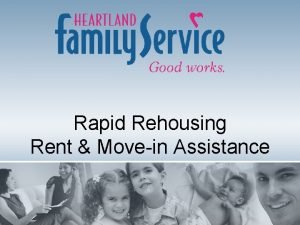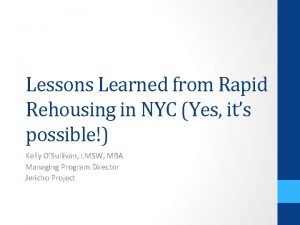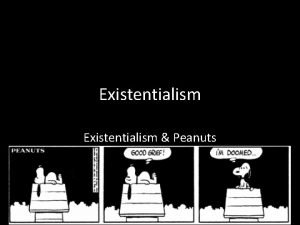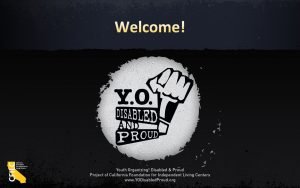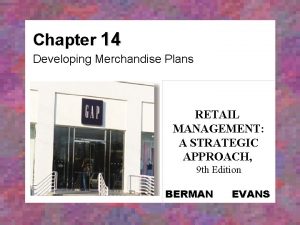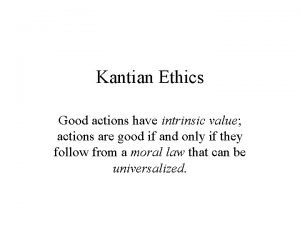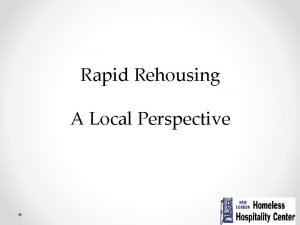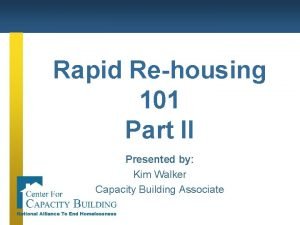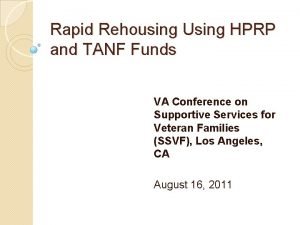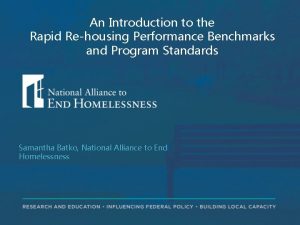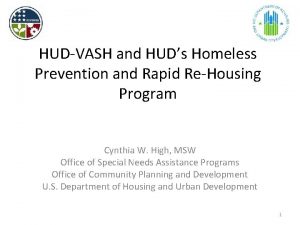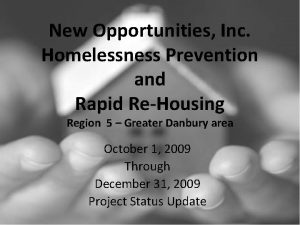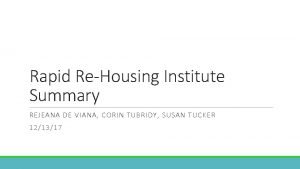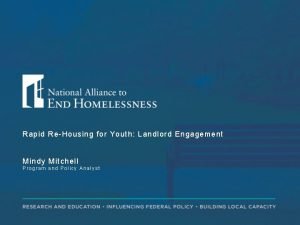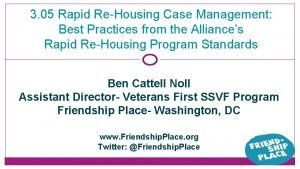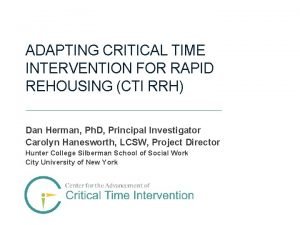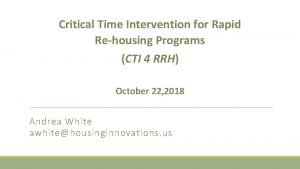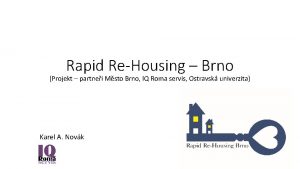Rapid ReHousing Rapid ReHousing Philosophy People who are



















































- Slides: 51

Rapid Re-Housing

Rapid Re-Housing Philosophy • People who are homeless can leave shelters or the streets and move directly into housing. • They should not have to spend time learning to live in housing before they move into housing. • People best learn to live in housing while they are living in housing. 2

Why? • Lack of stable housing is associated with: – Poor job retention; – Poor school attendance and poor academic performance (which is associated with lower graduation rates); – Increased use of alcohol/substances; – Less compliance with medical regimens (including medications); – Lower T-cell counts • Fix the housing FIRST and people have a stable base from which to tackle other life problems 3

Why? • When we lose our housing, our entire environment changes substantially. Our routines are disrupted; survival “rules” change. • When we lose our housing, the lack of a controllable environment triggers a “fight or flight” response, with changes in hormones, cardio-vascular functioning, respiration, etc. • If order/predictability is restored, functioning will return to normal—quickly or slowly—in most people. If the situation continues, stress becomes the “new normal” and has longerterm consequences for health and functioning. • Maslow’s Hierarchy has a biological basis. We focus on survival and are unable to consider “higher” goals until basic needs are met. • By restoring housing, people restore balance and may then have the option of focusing on other important life goals. 4

And… Every survey that asks people experiencing homelessness what they want comes to the same conclusion about their priority: Housing! 5

Rapid Re-Housing What Rapid Re-Housing doesn’t do Reduces the length of time people are homeless Minimizes the impact of homelessness on their employment, school attendance and health compliance Cure poverty Assure people will have affordable housing; i. e. eliminate rent burden Protect them from the impact of the housing market, job market, bad choices or bad judgment Allows people to access resources Eliminate housing mobility that can help with their other longer-term life problems and goals if they choose 6

How much help do people need? Think about the severity of people’s housing barriers as if they fall along the normal distribution curve, from no barriers to multiple, severe, pervasive housing barriers. What portion of the Bell Curve does your RRH program target? 7

Comparison: Different “Housing First” Programs with Different Targets Pathways to Housing Rapid Exit Target Population Chronically homeless adults with serious mental illness and co-occurring substance disorder: most severe end of the “Bell Curve” Homeless families with moderate to severe housing barriers: broad center (80%) of the “Bell Curve”– at least until 2008 Services Rent subsidy; 24/7 supports by staff team; permanent— no limit to service length Rental start-up costs almost exclusively; case manager with caseload of 40; sixmonth limit to services Outcomes 80% non-return to homelessness in two years 95% non-return to shelter in one year 8

Comparison: Similarities in Pathways and Rapid Exit • People experiencing homelessness exit directly into permanent housing; treatment and/or sobriety is not a prerequisite for housing. • Program staff provide tenancy supports. Supports are attached to the people, not the building; if the tenant moves, the services follow. • People can choose “therapeutic” services if/when they want them, from the provider of their choice. • They have the same legal rights as any other tenant. • The program recruits and supports landlords by minimizing their risks and intervening in situations of non-payment, lease violations, property damage and/or conflict. • Financial assistance is available to secure housing and, hopefully, when needed, to keep it. 9

The only real methodological difference between Housing First programs for a wide variety of subpopulations is the duration and intensity of tenancy supports and the specialized expertise of the staff. …Oh, yes, the ability to subsidize rent is really, really nice! 10

Components of a High-Performing Rapid Re-Housing Program • Rapid engagement with people experiencing homelessness • Targeting, screening and assessment is focused on housing barriers • Assistance is available for start-up costs and housing search • The program builds relationships with as many landlords as possible (except “slumlords”) • Tenancy supports are focused on keeping housing, including understanding Landlord-Tenant Rights and Responsibilities 11

Brief Review SSVF Requirements • The SSVF Program’s purpose is to provide supportive services to very low-income Veteran families who fall into one of three categories that define “Occupying Permanent Housing. ” Categories 2 and 3 are the focus of Rapid Re-Housing (although relocation as a strategy to prevent homelessness, i. e. Category 1, uses the same methodology). • Grantees must use a specific percentage of SSVF funds towards each category. • There are time restrictions and limitations on uses of grant funds with respect to the categories. 12

Categories of Occupying Permanent Housing Category Time Restriction Category 2 A very low-income Veteran family is homeless and scheduled to become a resident of permanent housing within 90 days pending location or development of housing suitable for permanent housing So long as the participant continues to meet the definition of Category, even if the participant does not become a resident of permanent housing within the originally scheduled 90 -day period. Category 3 MUST have exited permanent housing within the previous 90 days to seek other housing that is responsive to the very low-income Veteran family’s needs and preferences A grantee may continue to provide services until the earlier of the following dates: • Participant commences receipt of other housing services that meet their needs; OR • 90 days from the date the participant exits permanent housing. MUST have a 90 day plan in place Plan must be updated if there are delays in move, and identify cause for delay and plan to address Grantees MUST use between 60 -75% of supportive services funds on participants who fall within these two categories 13

Outreach—Finding Households • Develop relationships with agencies most likely to see very low-income Veteran households experiencing homelessness: – – – – – Public assistance benefits offices VA programs Churches, Temples, Mosques Hospitals and free clinics Detox centers Police Homeless assistance programs Drop-In centers Hot meals programs and food shelves 14

Outreach (cont. ) • For outreach to Veteran families who are not already involved with community resources, identify the locations where people experiencing homelessness camp: – Underpasses/Bridges – Abandoned buildings – Parking lots where homeless families sleep in their car (Walmart, churches/temples/mosques) – Stand Down events 15

Rapid Engagement • The promise of a quick move into permanent housing is highly motivating • Demonstrate respect by not asking too many personal questions or requiring too much commitment too quickly • Cultural competency is critical—sharing a major similarity: race, language, gender, experience with homelessness, etc. • Staff who have personally experienced homelessness can make an instant connection; they offer practical strategies and are an inspiring role model. 16

Targeting How deep can you target with the resources you have available? • Philosophy: How much help do you assume people need to leave homelessness? • Skill/Expertise: How much experience do you have with Rapid Re-Housing? • Supportive Services: How accessible are longer-term supports in your community? • Market: How do the characteristics of your housing market affect landlord recruitment? • Financial: How accessible are rental subsidies? 17

Targeting Recommendation: If you have little experience with Rapid Re-Housing and only newly-established relationships with a few landlords, start with tenants who have fewer or less severe barriers. Once you have more expertise and a loyal cadre of landlords, begin to target households with more barriers. Households with more barriers are not less likely to be successful, but they are more likely to cause worry to your landlords—and staff. 18

Screening Recommendation: 1. Limit screening to identifying and documenting SSVF eligibility requirements and any additional eligibility requirements your program has added. 2. Develop a method of prioritizing “admission” to your program and use it during screening when you have more Veteran families than you can assist. Consider both time urgency and vulnerability (resulting from homelessness or continued homelessness). 19

Assessment: Tenant Screening Barriers • Tenant background checks are used by landlords to screen out prospective tenants based upon their prior history. Their assumption is “history repeats itself. ” THE QUESTION: How difficult will it be to convince a landlord to rent to this household? • Tenant Screening Barriers are the negative things a landlord would find if they buy or conduct a tenant background check. These may cause the landlord to deny the application: 1. Income– too low 2. Source of income– too irregular 3. Credit history– too many debts, late payments, court judgments 4. Rental history– late payments, evictions 5. References from prior landlords– lease violations, damage to the unit 6. Criminal history– especially drug offenses or crimes against people or property 20

Assessment: Housing Retention Barriers • These are patterns of deficits/problems with income, skills, knowledge, relationships, communication style or other areas that have led to inability to pay the rent, follow the lease, take care of the landlord’s property and/or get along with other tenants (and the landlord). • Some barriers will be obvious to the household; they may be unaware of others, particularly the “soft skills” of renting, such as <unstated> minimum expectations for housekeeping, behavior in public and appropriate communication, parental behavior, etc. 21

Assessment: Housing Retention Barriers Assessing Housing Retention Barriers: 1. Discuss the contents of the Tenant Screening Report with the household, with the goal of identifying the reasons and patterns behind barriers 2. Observe household and housing unit during site visits 22

Assessment Recommendation: 1. Buy a Tenant Screening Report or create your own ASAP to identify the Tenant Screening Barriers that will determine how to do a successful housing search 2. Discuss Housing Retention Barriers over time, as appropriate to the situation and the relationship 3. Keep the “ 90 day rule” in mind. Despite Tenant Screening Barriers, your GOAL is that the participant will move into permanent housing within 90 days. If this isn’t possible, revise the plan and/or improve your landlord negotiating skills! 23

Start-Up Costs • A household that loses their housing because they were $200 short on the rent or has been doubled up after losing their housing is not likely to have $2000 to cover security deposit, first/last month’s rent, etc. • Sometimes it’s also necessary to pay arrears to a former landlord to find a new landlord. (Sometimes, it’s not—assess carefully!) • A family relying on public assistance (TANF) could remain in shelter for three months or more just to save enough for housing start-up costs. 24

Housing Search • Don’t assume households will substantially increase their incomes. • Wherever possible, very low-income households should apply for any type of subsidy for which they qualify, even if there is a waiting list. • Help households consider the smallest unit they can tolerate in the least expensive area where they can find safe housing. • Help the participant consider shared housing as an option. 25

Housing Search—Tenant Screening Barriers are Barriers! • Poor people are not competitive in tough housing markets! Poverty leads to exactly the kind of barriers that cause landlords to deny their application: late rent and/or eviction, too much debt, missed loan/credit payments. • In a cross-section survey of 3, 200 public assistance clients, 93% had at least one moderately serious to extremely serious housing barrier. Only 4% of currently homeless households and 9% of families who relied on TANF had no housing barriers! • Assistance with a housing search strategy is essential to securing <non-slumlord> housing for very low-income homeless people. The key to this strategy is recruiting landlords. 26

Recruiting Landlords = Understanding Their Perspective And helping your tenants understand, too! THINK LIKE A LANDLORD…… WOULD YOU RENT TO YOU? What kind of tenants do landlords want? • --Someone who will pay the rent on time. • --Someone who will take good care of the property. • --Someone who won’t upset other tenants in the building. • --Someone who won’t get the landlord in trouble with the police. 27

Pay the Rent on Time • Landlords have bills to pay, too. Usually, cash flow for the entire operation requires that most tenants pay their rent on the 1 st. • Exceptions can be made, but the tenant has to request an extension in advance, provide a plan for payment, and follow through. • Cash flow is particularly important for smaller landlords—who are most likely to be flexible about housing your Veteran families. 28

Treat the Building With Respect • Much tenant damage results from carelessness and ignorance • Lack of simple, minimal housekeeping can cause significant and expensive damage • Use of wrong cleaning products or tools can also damage tile, flooring, counters, sinks, etc. • Abuse of plumbing! • Fire-safety • And, of course, there can be deliberate damage……. . 29

Treat Other People With Respect • This means other tenants, nearby neighbors and, of course, the landlord. • Noise is a significant threat to relationships with other tenants. • Landlords in many areas cannot turn a blind eye to drugs: they can lose their license or even their property. • “Lease violations” are often based on local laws— under-age drinking, occupancy standards, etc. ; don’t blame the landlord for enforcing them. 30

Recruiting Landlords YOUR JOB: • Minimize risks to the landlord • Respond to problems caused by your program household • Provide housing-related support to the household • Act as an intermediary with the landlord • Facilitate a move-out vs. an eviction • Source of future tenant referrals • Extra incentives for households with the highest barriers: – Double damage deposit – Court eviction costs if needed – Repair or pay toward some damages 31

What Rapid Exit Offers to Landlords (Recommendation) • Basic Package for all Veteran families: Home visits; rapid response to landlord calls; corrective measures for lease violations; assure rent paid; help tenant move if no resolution is possible. And make future referrals! • Add-On’s for more difficult-to-house tenants or very tight housing markets: Pay or repair damage; pay eviction court costs; co-sign lease for some mutuallyagreeable period of time (afterwards, lease changed to tenant’s name); or sign the lease and sub-lease (if allowed) to your Veteran family’s name. 32

Recruiting Landlords Where to Find Landlords: • Relationships/“ 3 degrees of separation” • Associations (of landlords, businesses, civic organizations, churches) • Classified ads • FOR RENT signs in likely neighborhoods: drive around. Smaller landlords often do not list their vacancies online/in print. 33

Recruiting (and Keeping) Landlords Making the Pitch: • Your agency’s reputation • References from other landlords who work with you • What you offer and why it’s a win-win Decide who your landlord will call– the tenant household’s case manager or a specialized admin staff. Build the relationship: never burn a landlord, express appreciation when due, but also expect decent housing and maintain Veteran family confidentiality 34

Tenancy Supports FOCUS, FOCUS: 1. Meeting landlord requirements 2. Increasing income (and in-kind resources) 3. Minimizing expenses (subsidy? relocation? shared housing? ) 4. Budgeting skills or interventions (such as representative payee, if appropriate) 5. Household priorities 35

Helping Your Tenants Meet Landlord Expectations THE LEASE: • Read and explain the lease— in simple terminology (or have a tenant/legal service provider do it). Be sure the information is written in the tenant’s first language; use a translator if needed. • Assure they have a basic understanding of tenant and landlord rights and responsibilities. 36

Example: Understanding the Lease: WHAT DOES MY LEASE SAY? Things that can get me evicted: q Rent is more than 5 days late q Someone moves in with me (stays more than 2 weeks) q I get a dog q The police are called about me twice in 30 days q Anyone buys or sells drugs in my unit Things I can do but only if the landlord agrees: q Get a roommate (not just a guest) q Get a cat 37

Example: Understanding the Lease: WHAT DOES MY LEASE SAY? Things I should report to the landlord: q Damage or repairs that are needed q If there is a plumbing leak, I should call the landlord right away, day or night q If I am going to move out (tell landlord 30 days before I leave) 38

Helping Your Tenants Meet Landlord Expectations (cont. ) HOME VISITS: • Use drop-in visits to look for “red flags” (if a landlord suddenly evicts your participant, you haven’t been paying attention) • Home visits are also a good time for “in vivo” teaching about noise levels, garbage removal, basic housekeeping—the “soft skills” of renting. 39

Helping Your Tenants Meet Landlord Expectations (cont. ) ANTICIPATE PROBLEMS: • Plan ahead, with your participant, about how to respond if the rent will be late or partial pay • Consider other issues that have affected housing in the past and develop (with your participant) a plan to prevent or resolve them 40

Helping Your Tenants Meet Landlord Expectations (cont. ) COMMUNICATIONS/ROLE PLAY: • How to respond if the landlord (or another tenant) makes a complaint about you • How to make a complaint to the landlord (repairs, other tenants, etc. ) 41

Tenancy Supports: Increasing Income/Assets • Employment: better wages, more hours, second job, additional shifts, and/or day labor. SSVF: VA vocational and rehabilitation counseling; Employment and training services; Educational assistance; Transportation; Child care AND/OR • Temporary or Ongoing Public assistance: Earned Income Tax Credit, TANF, SSI, local programs (like General Relief). SSVF: Temporary Financial Assistance; Income support services; Housing counseling—rental/rent subsidy programs. 42

Tenancy Supports: Minimizing Expenses • Rent subsidies: VASH, Public Housing, Section 8, subsidized buildings (tax credits, etc. ) SSVF: Temporary Financial Assistance; referral to Federal, State or Local programs • Relocation/Downsize housing: Less expensive and/or smaller unit, less desirable neighborhood, shared housing (roommate) SSVF: Housing counseling—housing search assistance, Temporary Financial Assistance for deposits. 43

Tenancy Supports: Minimizing Expenses (cont. ) • Reduce Discretionary Expenses: Re-think need for expensive cell phone plan, cable TV, Internet; Sell or downsize car; Maximize use of freebies and cheapies-- food shelves, consignment clothing, free community entertainment. SSVF: Personal financial planning services; Fiduciary and representative payee service. 44

Tenancy Supports: Budgeting or Rep Payee/Vendoring • The less money a household has, the greater the need to budget; at the same time, even with budgeting, there is little room for error. • Is there any way a household can set aside any money for emergency reserves? (Can you subsidize more deeply and assure the HH banks part of their normal rent payment into an “emergency-only” account? ) • Sometimes, people know they can’t assure payment of the rent—e. g. they may have a partner/spouse who takes their money. They may be willing to have rent automatically paid to the landlord—via representative payee or vendor pay. 45

Tenancy Supports: FAQs • Won’t people who secure housing without requirements for sobriety or treatment use/abuse chemicals and end up homeless again? -----------------------------------This doesn’t appear to happen. Comparison of randomly assigned participants in Pathways to Housing (harm reduction, no treatment required) vs. traditional (sobriety required) programs found no differences in chemical use. A harm-reduction PSH program for end-stage American Indians in Minneapolis has found that when the pressure to maintain sobriety is removed, some severely alcoholic residents decided to stop drinking and achieved sobriety. 46

Tenancy Supports: FAQs • How can you help households with housing retention if they are free to “fire” the service provider as soon as they are in housing? ------------------------------------When the case manager is person-centered, respectful and works hard at engagement, permanent “firing” doesn’t happen. Program participants should look forward to staff visits. Bringing toys, a toaster (i. e. “bribes”) also helps repair a relationship problem!

Tenancy Supports: FAQs • Without ongoing rental subsidies, how can people at 30% or less of AMI sustain housing? We can get them the housing, but they won’t be able to keep it. ------------------------------------According to national studies, in a year, about 10% of people who rely on public assistance (and are at 15 -20% AMI) become homeless. That means 90% do, somehow, maintain their housing, even though very few have rental subsidies. In Hennepin County’s Rapid Exit program, nearly all homeless families had incomes below $500/month. Once re-housed, only 5% became homeless within 12 months of leaving shelter—and the program does not provide more than extremely short-term, shallow rent subsidies (and most families receive no subsidy).

Tenancy Supports: FAQs • Don’t homeless people need ongoing supports rather than short-term services? Won’t they lose their housing as soon as services end? -----------------------------------Among the 5% of Hennepin’s Rapid Exit families who returned to shelter, there was no pattern to when they became homeless again. Some became homeless while receiving services; others were spread out among the 6 months following service termination. There was no clustering of recidivism soon after services ended.

Moral of the story: James “Whitey” Bulger, Boston gang boss, was not really all bad… • He had 30 guns and $800, 000 hidden in the walls of his apartment and is accused of 19 murders. Whitey was on the FBI’s Ten Most Wanted List until he was caught just a few weeks ago. • According to the apartment manager, Whitey had lived in the same apartment for 15 years, paid his rent on time and made few complaints. • “He was a good tenant. ” <but after those holes in the walls, he probably won’t get his full damage deposit back!> 50

Questions? 51
 Insidan region jh
Insidan region jh Rapid rehousing omaha
Rapid rehousing omaha Anne marie pierce
Anne marie pierce Rapid rehousing nyc
Rapid rehousing nyc People killin people dyin
People killin people dyin Transformed people transform people
Transformed people transform people People just people
People just people People=sh
People=sh Death penalty philosophy
Death penalty philosophy Ant philosophy
Ant philosophy Why is philosophy important
Why is philosophy important Quescussion
Quescussion Teaching philosophy
Teaching philosophy Philosophical question about love
Philosophical question about love Absurdism
Absurdism Cosmocentrism philosophy
Cosmocentrism philosophy Progressivism in education
Progressivism in education No wrong door philosophy
No wrong door philosophy Analytic philosophy of education
Analytic philosophy of education Existentialism examples
Existentialism examples John locke philosophy of education ppt
John locke philosophy of education ppt Working stress method and limit state method
Working stress method and limit state method Fifa grassroots football
Fifa grassroots football Zaha hadid philosophy
Zaha hadid philosophy Plato philosophy summary
Plato philosophy summary Esd philosophy
Esd philosophy Research philosophy
Research philosophy Independent living philosophy
Independent living philosophy Immanuel kant main ideas
Immanuel kant main ideas Inductive reasoning examples
Inductive reasoning examples Research philosophy
Research philosophy Metecil
Metecil Philosophy of physical activity
Philosophy of physical activity Humanistic philosophy
Humanistic philosophy Whose philosophy made the most sense
Whose philosophy made the most sense Hippolyte taine philosophy of art
Hippolyte taine philosophy of art Sui dynasty philosophy
Sui dynasty philosophy Empiricism and the philosophy of mind
Empiricism and the philosophy of mind Ethical principles of scholastic ethics
Ethical principles of scholastic ethics What is kantianism
What is kantianism Philosophy 120
Philosophy 120 Allama iqbl
Allama iqbl In the lean philosophy, the ideal lot size is
In the lean philosophy, the ideal lot size is Ay history
Ay history Puzzle pirates server
Puzzle pirates server The philosophy of vishishtadvaita was preached by
The philosophy of vishishtadvaita was preached by Subjectivism research philosophy
Subjectivism research philosophy What is postmodern philosophy
What is postmodern philosophy 3 vs of concentrix
3 vs of concentrix Parenting philosophy
Parenting philosophy Philosophy for old age (absolutely brilliant)
Philosophy for old age (absolutely brilliant) Rabindranath tagore education
Rabindranath tagore education

